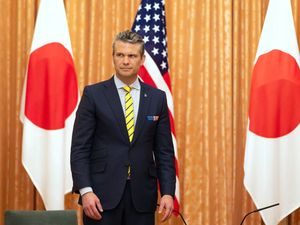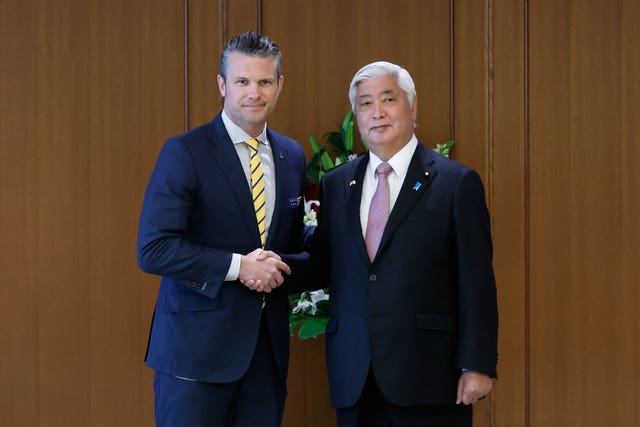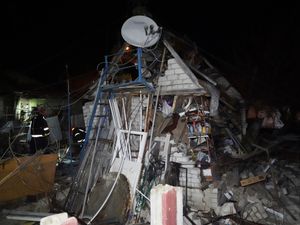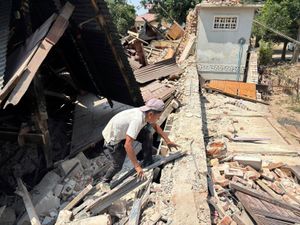US defence secretary praises ‘indispensable partner’ Japan
Pete Hegseth stressed the need for both countries to do more to accelerate the strengthening of their military capability.

US defence secretary Pete Hegseth has called Japan an “indispensable partner” in deterring growing Chinese assertiveness in the region.
Mr Hegseth announced upgrading the US military command in Japan to a new “war-fighting headquarters”.
On his first Asia trip with Japan as his second stop, Mr Hegseth also stressed the need for both countries to do more to accelerate the strengthening of their military capability as the region faces China’s assertive military actions and a possible Taiwan emergency.
“Japan is our indispensable partner in deterring communist Chinese military aggression,” Mr Hegseth said at the beginning of his talks with Japan’s defence minister Gen Nakatani in Tokyo.
“The US is moving fast, as you know, to re-establish deterrence in this region and around the world.”

His comments come as an assurance at a time when Japan has been worried about how US engagement in the region may change under President Donald Trump’s “America First” policy, Japanese defence officials said, speaking on condition of anonymity.
Mr Trump has also threatened to impose trade tariffs on Japan, a key US ally, sparking more concern.
The two sides agreed to accelerate plans to jointly develop and produce missiles such as advanced medium-range air to air missiles (MRAAM) and consider producing SM-6 surface-to-air missiles, to help ease a shortage of munitions, Mr Nakatani said.
The ministers also agreed to speed up the process involving the maintenance of US warships and warplanes in Japan to strengthen and complement Japanese and US defence industries.
Japan and the US decided in July to upgrade the command and control of the Japanese military as well as US forces in the east Asian country, under the Biden administration, a major structural change aimed at bolstering joint operational and response capabilities. Japan is home to more than 50,000 US troops.
Tokyo last week launched the Japan joint operations command (JJOC), whose mission is to co-ordinate Japanese ground, maritime and air self-defence forces, in a significant action to further strengthen capabilities to respond to contingencies and better co-operate with the US.
Mr Hegseth announced on Sunday the upgrading of its current command, US Forces Japan, by placing a unified operational commander to function as a joint force headquarters to liaise with its Japanese counterpart to serve as “war-fighting headquarters” to bolster speed and capability of their troops’ joint operations.

The Pentagon chief said the reorganisation of US troops is a step to better prepare for a possible conflict. America and Japan both work for peace, but “we must be prepared,” he said.
Japanese defence officials say they are not expecting a significant change in their responsibilities or an increase in US troops in Japan.
Mr Hegseth and Mr Nakatani told a joint news conference they have also agreed on the need to beef up Japan’s defence posture on the Southwestern islands, which are in critical locations along the disputed areas in the East China Sea and near Taiwan to further step up deterrence against China.
He stressed the need to have “sustaining, robust, ready and credible deterrence” in the Indo-Pacific, including across the Taiwan Strait, as “Japan would be on the front lines of any contingency we might face in the western Pacific”.
China claims Taiwan as its own territory.
The US is obligated under a 1979 law to provide Taiwan with sufficient military hardware and technology to deter invasion, and its arm sales to Taiwan have always drawn strong opposition from Beijing.
On Saturday, he joined the US-Japan joint memorial to honour the war dead in the Battle of Iwo Jima as they marked the 80th anniversary of the end of one of the fiercest battles of the Second World War, praising the strong alliance between the former enemies.
Before landing in Japan, Mr Hegseth stopped in the Philippines, where he also ensured Mr Trump’s commitment to step up ties with the south-east Asian country that faces maritime disputes with Beijing.





